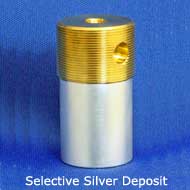What Is Plating? Why Is It Necessary?
The Historical Connection: Making A Tool
Historically, the manufacture of a part or tool was dictated by the manufacturing process. Prehistoric man made cutting tools and weapons out of flint because the only process available to him was to shape flint with other rocks. Working with pure metals such as gold came about when the malleable properties of gold were discovered. The bronze age started when the science of the day learned how to melt and create certain alloys (copper & tin). In short, as technology advanced so did the use of more and different materials.
Dictated By The Manufacturing Process
Today, the selection of the material out of which a part is made is still often dictated by the manufacturing process, although other factors such as weight may also play a role in the choice.
Common Base Materials
- Aluminum
- Copper
- Brass
- Beryllium Copper
- Steel
- Kovar
- Stainless Steel
- Zinc Diecast
Less Common Base Materials
- Nickel
- Monel
- Tungsten
- Molybdenum
- Cast Iron
- Metalized Plastics or Ceramics
Not Always The Right Choice Of Material
Unfortunately, the material used - while ideal for manufacturing - might have other detrimental properties. For example, the material may not have the desired appearance. It may corrode too readily in the environment in which it is to be used.
A Part's Use Dictates The Final Plating Choice
How and where a part is used dictates what type of desirable properties that part needs to have. Desirable properties can be:
- Contact Resistance
- Solderability
- Corrosion Resistance
- Electrical Conductivity
- Thermal Conductivity
- Shelf Life
- Wear Resistance
- Lubricity
- Porosity
- Temperature Resistance
- Ductility
- Reflectivity
- Uniform Thickness
- Appearance
Why Plating Is Used
Quite often, the answer to the above listed problems is to place a metal coating onto the surface of the part. The characteristics of the coating can impart the properties that are needed to the surface. The most common way of obtaining the desired coating is to plate a metallic layer onto the base material.
Extensively Used In Industry Today
Plating is used extensively in every industry. For example, the aerospace, electronic, medical, oil and gas, automotive, food service, semiconductor, printing and jewelry industries all have need for plating.

